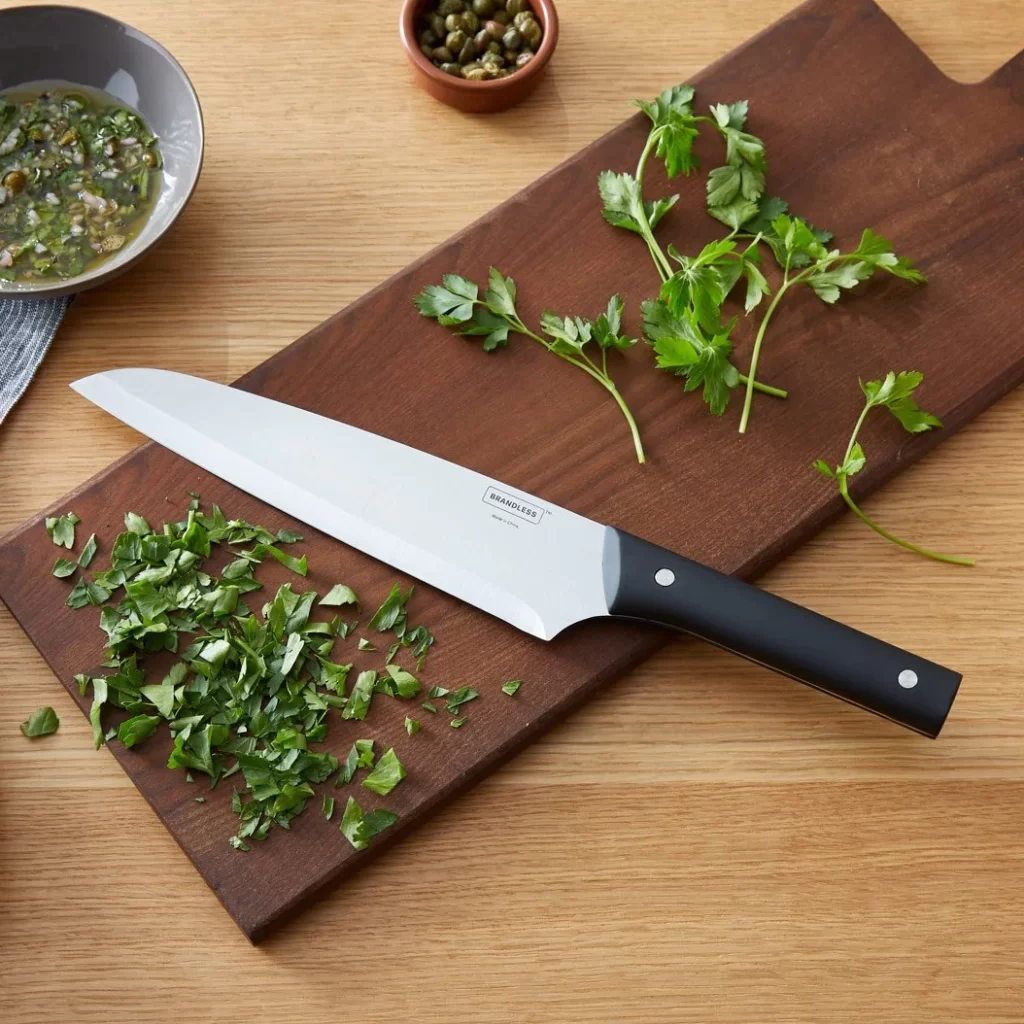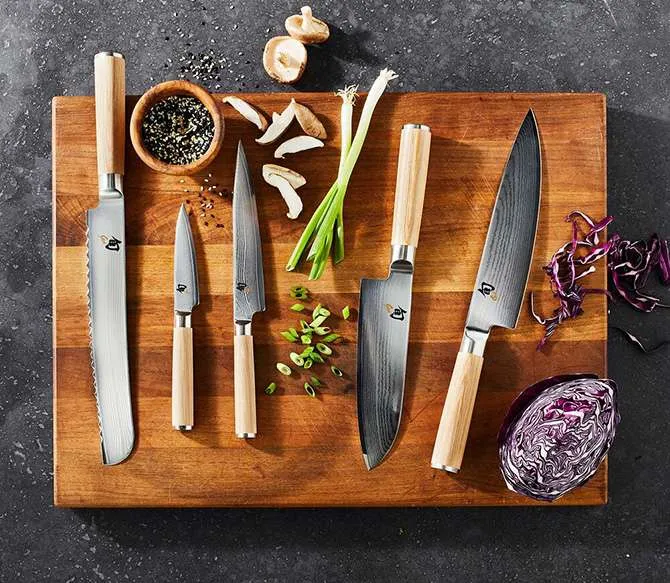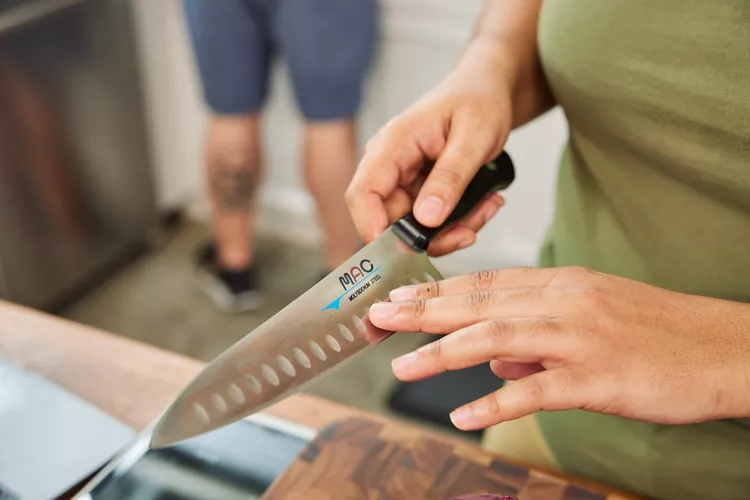Last updated on January 20th, 2024 at 03:23 am
Tools are essential for culinary excellence. Chef knives are essential. Every cook needs a chef knife. This page covers chef knives’ history, design, functions, and commonly asked topics. Start exploring chef knives!
What is a Chef Knife?
Chef knives, often known as cook’s knives or French knives, are the culinary world’s mainstays. It has a wide, sharp blade and a strong handle.
This knife is designed to slice and dice vegetables and cut large meat portions. Chef knives are essential to professional and amateur cooks because of their flexibility.
The History of Chef Knives
Chef knives are ancient. Ancient Egyptians made copper and bronze knives. They originally hunted and butchered meat. Chef knives evolved with civilization.
In the Middle Ages, blacksmiths made knives with stronger and sharper blades, advancing cooking tools.
Anatomy of a Chef Knife

Let’s examine a chef knife’s anatomy:
Blade
Chef knives are all about the blade. High-carbon stainless steel makes it durable and sharp. The blade is wide, tapering, and pointed. This design makes chopping, slicing, and mincing easy and precise.
Tang
Blade tangs extend into handles. Full-tang knives are balanced and strong since the blade runs the length of the handle. This structure gives the knife stability and durability.
Handle
Chef knives have wood, plastic, or composite handles. It should be ergonomic and pleasant to prevent hand fatigue. The handle is riveted or glued to the tang for durability.
Bolster
The bolster is the thick metal piece between the blade and handle. It improves knife control and safety by adding weight, balance, and stability. A good bolster protects the user’s fingers from slippage.
What Sets a Chef Knife Apart?

Chef knives excel in versatility and functionality. Some distinguishing features:
Multi-Use Blade
Chef knives are versatile. The chef knife cuts vegetables, herbs, and meat with accuracy. Its curved edge offers smooth rocking for efficient chopping and mincing.
Weight, Balance
Well-made chef knives balance weight and agility. Balance and weight make cutting easy and reduce hand and wrist strain. This combination improves cutting actions.
Ergonomics
Chef knives need ergonomics. The handle is ergonomically designed for a stable grip and reduced accident risk. A well-designed handle supports optimal hand placement and reduces fatigue, helping cooks operate efficiently for long durations.
Versatility
Chef knives are unmatched in kitchen versatility. This all-purpose knife can chop garlic or disassemble a chicken. Precision and heavy-duty cutting are possible with its broad blade and sharp edge.
Efficiency
Chef knives make professional kitchens efficient. Chefs can cut quickly and efficiently with its razor-sharp edge. Cooks can chop, slice, and dice materials in a fraction of the time with this knife due to its efficient blade design and rocking motion approach.
After defining a chef knife, let’s look at what makes an excellent one. Chef knife selection criteria include:
What Makes a Great Chef Knife?

Superior Materials
High-quality materials ensure durability, sharpness, and lifespan in a chef knife. High-carbon stainless steel knives retain edge and resist corrosion. A robust handle improves the knife’s quality.
Weight Distribution
Cutting is easier with a well-balanced kitchen knife. The blade and handle should be evenly weighted for easy handling and wrist relief. Try different knives to find one that fits your hand.
Sharpness/Edge Retention
Sharp chef knives allow accurate cutting. Choose knives with factory-sharpened edges or that are easy to sharpen. Since they don’t need to be sharpened often, knives with good edge retention save time.
Easy Grip
Choose a knife with a comfortable handle as you’ll be holding it. Handle shape, grip, and material matter. Some handles are ergonomic, while others have textured grips. The handle should be pleasant and secure for long-term use.
Reputation and Reviews
Read expert and home cook reviews before buying a chef knife. This shows the knife’s performance, durability, and quality. Find knives with good reviews and satisfied consumers.
Chef Knife FAQs
Which chef knives exist?
Chef knives have different designs and uses. French, Santoku, utility, and boning knives are prevalent. Each variety excels at different kitchen activities.
Chef knives for bread?
Chef knives can slice bread, but they’re not perfect. Chef knives are better for cutting vegetables, meats, and herbs due to their wide, flat blades.
A serrated bread knife’s toothed blade retains the crust without crushing the soft center, making bread slicing easy and precise.
Chef knife sharpening frequency?
How often you sharpen your chef knife depends on how often you use it and your cutting board. For household use, sharpen your chef knife every few months.
However, if the blade feels dull or cuts poorly, sharpen it. Regular honing can keep the edge sharp between sharpenings.
Chef knives for peeling fruits and vegetables?
Chef knives can peel fruits and vegetables, but they’re inefficient. Chef knives are difficult to use on tiny or curved surfaces due of their wide blades.
Paring knives have narrow, sharp blades for precision peeling and trimming.
Conclusion
Any cook—professional or amateur—needs a chef knife. Its versatility, efficiency, and ergonomic design make it the go-to for many culinary jobs. You may improve your cooking skills by buying and caring for a good chef knife.
When choosing a chef knife, consider materials, balance, and sharpness. With a good chef knife, you can handle any culinary difficulty.
